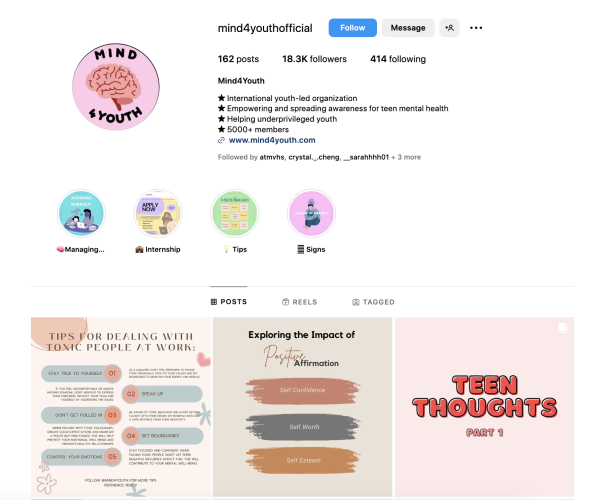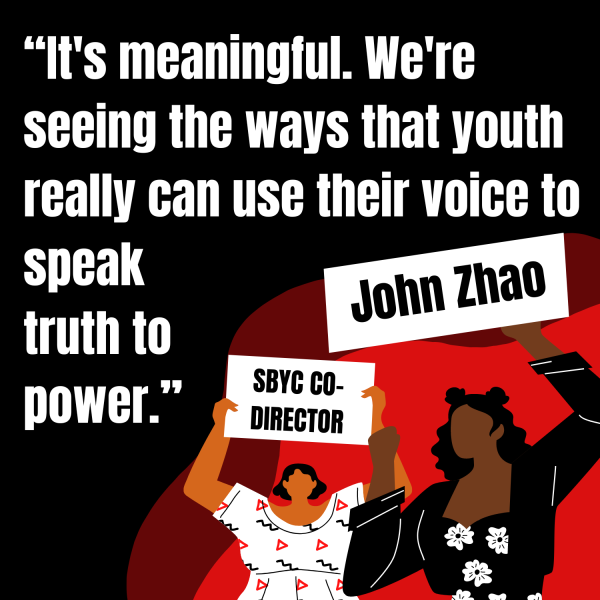South Bay Youth Changemakers (SBYC) Co-Director and Cupertino High School alum ‘14 John Zhao remembers starting SBYC at the onset of the pandemic. He recognized the need for an organization to support young Asian Americans in Santa Clara County with community organizing, bringing a diverse perspective in tackling issues like economic and racial injustice. Zhao says that the organization was one he wished he had while attending CHS.
With over 700 nonprofit organizations based in Cupertino, many MVHS students embrace activism by founding or joining a nonprofit. Senior Iniyaa Suresh joined Youth Environmental Power Initiative (YEPI) after learning about it from her friend and its founder, MVHS alum ‘23 Kelly Tung. While Suresh initially joined for volunteer opportunities, she quickly realized that she had a deeper interest in sustainability, which aligned with YEPI’s goals. Now, as co-president of the organization, Suresh says that YEPI participates in community events and social media engagement to further environmental justice and equity.
“There are a couple events that we participate in: we participate in the Cupertino Bike Fest, we do the Earth and Arbor Day Fair and sometimes we go to beaches to do beach cleanups,” Suresh said. “We also have a variety of online engagement content such as blogs and online art contests.”
Similar to Suresh’s motivation to drive change, sophomore Sarah Shelke founded Mind4Youth after seeing the stigma around mental health issues among students. Shelke says that Mind4Youth helps break the stigma by offering programs for youth to spread mental health awareness and drive social change.
“[Our] internship and volunteer programs are educational programs to help teach others about mental health,” Shelke said. “Our internship program offers youth the opportunity to learn about technical skills such as marketing, web design and editorials. We also have a volunteering program where youth can come and complete modules where they watch videos and articles, and after that, they’re able to complete a final project where we encourage them to take initiative in their own community by maybe starting a Mind4Youth chapter.”
As YEPI, SBYC, and Mind4Youth continue to grow, each organization notes that one of the main ways that it partakes in activism is through social media, engaging up to thousands of people. For example, Mind4Youth has collaborated with the Kendra Scott Foundation to share content and create more engagement around their messaging, emphasizing how mental health issues are common and how youth can seek help.
In addition to online engagement, nonprofits partake in in-person initiatives to share messages with the community around them. Suresh says that one of her proudest accomplishments for YEPI was their presentation at the Cupertino Bike Fest, which was held on Sept. 30, featuring bike rides, fun games, and safety checks. She explains that this event helped her move out of her comfort zone and bring more attention to YEPI and its mission of promoting environmental justice and stewardship.
“As a personal accomplishment, during the Bike Fest this year, I stepped out of my comfort zone to go approach people to bring them to our booth, because we were located in a weird spot and so a lot of people weren’t seeing the booth,” Suresh said. “Eventually we moved to more popular spots. We ended up getting 400 people who attended the booth. I felt that that was a big personal accomplishment because I’m usually a little shy whenever I go over to people randomly.”
Shelke shares that Mind4Youth’s biggest accomplishment was the outreach they were able to receive through the chapters they opened. She says Mind4Youth has grown to nine chapters with four thousand members in over 35 countries over the past few years. Zhao expresses how SBYC has also been able to gain a large membership of volunteers who care about its cause, engaging in everything from civic engagement to pass Proposition 15 during the 2020 elections to writing messages for a Palestinian protest in front of Rep. Ro Khanna’s house. For him, the most important part of SBYC’s work is relationship building and the dedication that members have for the organization.

“What’s most fulfilling is building a meaningful relationship with our members and staying with them and actually growing as leaders real-time over the course of a few years,” Zhao said. “What’s been the most meaningful is seeing how a lot of our members have blossomed into powerful people.”
Along with the impact YEPI, SBYC and Mind4Youth have had on students, they have also faced challenges such as improving club organization and forming a strong member base. Suresh describes that one of the biggest challenges for YEPI was the club’s transition after former president Kelly Tung graduated from MVHS. Afterward, it was initially a challenge to make sure they had members in place to help organize events.
“Some problems were finding the right leadership to manage the team and then just making sure that we got all the materials we needed,” Suresh said. “With this, we could connect with the people we need to or to continue hosting the events.”
Mind4Youth and SBYC faced similar challenges with recruitment. Shelke says that early on, her organization had to do extensive social media promotion to obtain volunteers. Since then, Mind4Youth has collaborated with other organizations to create more engagement with their activities. For SBYC, part of the challenge is finding people who are willing to work with them over a long period of time.
 “There’s a lot of young people who care about social justice, but they may not have the time to really commit to this,” Zhao said. “I think there’s a lot of causes for this. One of them is just the culture that we have in a lot of Silicon Valley schools. There’s this pressure on a lot of students to do a ton of APs and honor classes and not have any time left over to be specifically engaged in our community. We need committed members who can dedicate not just one summer with us but to continue with us throughout the years so that they can take on bigger roles.”
“There’s a lot of young people who care about social justice, but they may not have the time to really commit to this,” Zhao said. “I think there’s a lot of causes for this. One of them is just the culture that we have in a lot of Silicon Valley schools. There’s this pressure on a lot of students to do a ton of APs and honor classes and not have any time left over to be specifically engaged in our community. We need committed members who can dedicate not just one summer with us but to continue with us throughout the years so that they can take on bigger roles.”
Going forward, each organization hopes to continue engaging in activism through both online engagement on social media and physical initiatives. For example, Mind4Youth is working on creating mental health kits consisting of items like journals and stress toys to promote mental health awareness. Similarly, SBYC hopes to expand its fundraising efforts to support grassroots movements including protests, empowering youth to shift from individualistic activism to organized efforts with community leaders, making a broader impact.
“[I was told] that the things that your youth members said really moved me, brought me to tears,” Zhao said. “It shows that the work that we’re doing is noticeable. It’s meaningful. We’re seeing the ways that youth really can use their voice to speak truth to power.”










